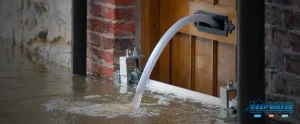Gabion is derived from the Italian word gabbione, which means “big cage”. It refers to an ancient wall-like structure that existed in Egypt around 7,000 years ago. At the time, the wall served as a fortress that protected the bank of the river Nile from being flooded.
During the middle age, the early gabion wall models became military forts for soldiers engaged in war. By the 1800s, gabions were used extensively by civil engineers to stabilize banks and coastlines, as well as control erosion.
Modern Gabion Walls
Modern-day gabion walls are erected primarily to help stabilize the soil behind them. However, they can also be used as cover walls.
Gabion baskets made of galvanized hexagonal meshes and filled with broken rocks are commonly used to build most gabion walls. Depending on how high you want the wall to be, these can be stacked in one or several rows. The baskets are closed at all sides and have a cage-like shape, which is why gabions are sometimes called gabion cages.
Benefits of Gabion Walls
Gabion walls can be built in a variety of sizes and colors and can provide you with the following:
1. Soil Erosion Prevention
This is the principal reason for building a gabion cage. In case of floods, the stones that fill the wall absorb the water’s force and dissipate it, effectively protecting the area. Gabions are also a practical and effective way of keeping your land dry if you happen to have a nearby stream or pond.
2. Environmental Safety
You can make gabion walls more eco-friendly by building them using recycled materials. Since the filling is made from available materials, there is no need for concrete or similar invasive materials that can affect the environment. Other than that, the basic gabion wall design allows floodwaters to flow through them, preventing floods. This makes gabions a friend of the environment.
3. Reinforced Structure
Although it may not appear so at first glance, one of the benefits of gabion walls lies in the wire mesh. It forms the basket or cage of the wall, acts as a reinforcement to the overall structure, and is stronger than it seems. The mesh even becomes stronger as the wall ages due to vegetation and silt that collect between the fillings over time. For this reason, creative people have even made gabion baskets as a base for benches and tables.
4. Breathing Space
Gabion cages are permeable and are designed in such a way that they leave space between the stone fillings. The design allows air and water to flow through the structure, allowing it to breathe. They are unlike impermeable concrete walls, causing hydrostatic pressure to accumulate, consequently leading to structural instability.
5. Permanence
Gabion walls have withstood the test of time since they were first built on the banks of the great Nile River. It is a testament to their flexibility and durability. While they could compress or deform under extreme stress, these walls won’t break. This functional feature prevents the wall’s structural integrity from being compromised but even makes it stronger over time.
6. Easy Installation
A typical gabion wall construction can be completed in one day if you research enough and have all the necessary tools and materials. Simply attach the baskets, prepare the ground so they can lie flat, and then fill them with the desired filling. The key is choosing the flattest pieces of rocks or stones you want for the sides. Many fill the center of the wall with cheaper fillings such as concrete and save any right-angled pieces for the corners.
7. Savings
Gabion walls made from wire mesh are cheaper than concrete and can be assembled easily. It is also possible to source the fillings, such as stones and broken concrete locally, and often at a lower price. Labor-wise, costs can be eliminated if you’re willing to build the wall on your own. The only exception is when you plan to put up a gabion cage higher than normal. In this case, a professional must be consulted to ensure safety.
8. Aesthetics
Gabion cages are beautiful and can blend in easily with the surrounding environment when made from natural materials. In this regard, stone blocks are often chosen for their aesthetic qualities, but you can consider other filling materials of varying sizes, colors, and textures.
How Long Do Gabion Walls Last?
One of the benefits of gabion walls is that they are intended to be used as permanent structures. However, their longevity will depend on the environment in which they are placed. Generally, these retaining walls have a life expectancy of 10 to 75 years. Still, factors like salt water, acidic oils, freshwater, and industrial run-off can all affect the structure’s long-term durability.
Also, some gabion types are more compatible with certain environmental conditions than others. PVC-coated gabion cages, for example, can be used in both acidic and freshwater surroundings. Customized stainless steel gabion walls, meanwhile, are often ideal in areas with saltwater. These gabion models can effectively protect shorelines and serve as solid and permanent structures that blend perfectly with the environment.
Gabion Wall Advantages and Disadvantages
Many of the benefits of gabion walls can be seen along the coast, where they are placed to stop erosion or divert water flow. They can be made from inexpensive materials and are easy to build, given the right and complete equipment. Since these walls are porous, they can retain soil or serve as drainage in other terrains. Their wire mesh is flexible and durable, so you can expect the cage not to crumble easily.
In terms of drawbacks, building a gabion can be labor-intensive. It is tedious to fill the wall with stones, gravel, and broken-up cement. It is especially true if you only use hand tools such as shovels and wheelbarrows. Also, building attractive gabion walls involves hard work and requires a creative mind. Many gabions don’t look good in a garden or yard because they have this heavy industrial appearance.
Key Takeaway
The early Egyptians initially used gabion walls to keep the floods away when the Nile River overflowed. Today, there is a resurgence of that important function as many gabion cages are being built to serve as a form of drainage whenever there’s a heavy downpour.
Gabion cages, however, do have other uses and purposes. It includes being an attraction piece of a house, which can happen if suitable filling materials are used. Nevertheless, it’s in ensuring the smooth flow of water that the benefits of gabion walls are best seen. During natural disasters like floods, these man-made fortresses can keep water from bringing damage to your property, so you don’t end up dealing with mitigation problems.
For water damage issues, contact Deep Water Emergency Services and Mitigation for a quick and complete solution.
Sometimes, water can be such a powerful and unstoppable force that even a strong and mighty wall can crumble to pieces. When water damage hits your home, you can trust Deep Water Emergency Services and Mitigation to be there and help you.
We are the experts in water damage mitigation and our service is top-notch. Reach out to our water damage mitigation Dallas professionals and expect immediate assistance. Don’t delay. Call now.






